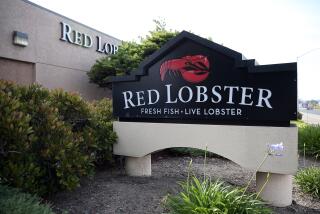Sears Gets Back to Basics : Allstate Insurance to Be Spun Off as Retailing Giant Returns to Its Roots
Sears, Roebuck & Co. all but completed a return to its 106-year-old retailing roots Thursday by announcing the spinoff of its huge Allstate insurance unit and signaling that the architect of its merchandising recovery will run the transformed company.
Sears said its chairman and chief executive for the last eight years, Edward A. Brennan, 60, will retire when the realignment is completed. Brennan recommended he be replaced by Arthur C. Martinez, 55, the man hired away from Saks Fifth Avenue in 1992 to revive Sears’ retailing operations.
Sears’ decision to spin off its 80.1% holding in insurance giant Allstate appeared to be the final major step in the merchandising company’s strategy of dismantling its multi-industry structure to focus on its core retailing business.
Sears executives said the distribution of the 360 million Allstate shares, valued at about $9 billion, would be one of the largest spinoffs in U.S. business history. They said holders of Sears common stock would receive almost one share of Allstate stock for each Sears share under the plan, which would be implemented sometime in 1995, subject to shareholder approval.
“Sears and Allstate are ready, and the economic environment is right, for these successful American franchises to operate as independent companies,” Brennan said in a statement.
Wall Street welcomed the news by bidding Sears shares up $2.75 to $51.625, while Allstate stock dropped 75 cents to $24.125. Sears also said it is exploring the sale of its Homart Development Co., a leading regional mall and community center developer with assets of $2.2 billion, including 18 office buildings and 32 suburban shopping malls around the country.
The company’s strategy of the last two years has been to remake Sears in its original image--to achieve an incarnation as a retailer without the distracting operational interests it has had in insurance, real estate and securities.
The effort began in September, 1992, when Sears announced it would sell its Coldwell Banker Residential Services realty unit and remove the Dean Witter Reynolds Financial Services Group out from under the corporate umbrella by spinning off most of it to Sears shareholders and selling the balance.
When the Allstate spinoff is completed, Sears will consist of about 750 department stores and about 1,200 specialty stores such as Homelife furniture and its Sears Hardware stores. It also owns 61% of Sears Canada and 75% of Sears Mexico.
Retail industry analysts said this new retail-focused entity will be tailor-made for Martinez, who has reversed Sears’ failing fortunes since the company hired him to head the Sears Merchandise Group.
Martinez is expected to named Sears’ next chairman and chief executive on the strength of Brennan’s recommendation. Brennan made his choice public Thursday when he announced that he would retire after the Allstate spinoff.
“After all of this restructuring, the company would have been top-heavy with both Brennan and Martinez because Sears is now in need of one leader to steer its retailing operations,” said Richard Nelson, an analyst at Duff & Phelps in Chicago. “Brennan restructured the company and Martinez is well qualified to manage it.”
Nelson said Martinez has earned the trust of Sears shareholders by closing poorly performing stores and cutting costs. Among his bold strokes was a January, 1993, decision to close Sears’ venerable but flagging catalogue sales operations.
By cutting costs, Sears was able to lower prices and attract more value-conscious consumers, said Kurt Barnard, a New Jersey-based retail economist.
Martinez “has worked wonders for the company,” Barnard said.
Industry analysts also credit Martinez with expanding the amount of store space devoted to apparel and for displaying it more attractively--changes that have generated increases in clothing sales.
The retail turnaround helped Sears rebound in 1993 with earnings of $2.3 billion after a record loss of $3.9 billion in 1992.
Given that Allstate was an important contributor to those profits, analysts said Thursday’s decision is a “vote of confidence” in Sears’ current retail operations.
Sears Refocuses on Retailing
Sears, Roebuck & Co. announced that it is spinning off Allstate insurance, the latest in a series of company moves to focus on its core retail operations. Some major developments in the company’s transformation:
* 1978: Sears decides to make itself less dependent on retailing.
* 1981: Acquires real estate broker Coldwell Banker & Co. and securities broker Dean Witter Reynolds.
* 1985: Launches Discover card.
* 1987: Buys Eye Care Centers of America Inc.
* 1989: Kicks off short-lived “everyday low prices” strategy.
* 1991: Slides from No. 1 to No. 3 among U.S. retailers, behind No. 1 Wal-Mart and No. 2 Kmart.
* 1992: Hires Arthur C. Martinez from Saks Fifth Avenue to head retail division.
* 1993: Spins off Dean Witter and Discover Co., sells Coldwell Banker and Eye Care Centers, announces elimination of 50,000 jobs and closure of 113 of 850 stores, discontinues its well-known catalogue.
* 1994: Announces a financial rebound and says it will sell Sears Tower in Chicago and spin off Allstate.
REVENUE (in billions of dollars):
1993: $50.84
EARNINGS (in billions of dollars):
1993: $2.37
STOCK PRICE
Thursday: $51.625, up $2.75
Source: TradeLine; company reports
* DEAL’S IMPACT: Allstate investors could be pinched in the short term. D14
More to Read
Inside the business of entertainment
The Wide Shot brings you news, analysis and insights on everything from streaming wars to production — and what it all means for the future.
You may occasionally receive promotional content from the Los Angeles Times.










